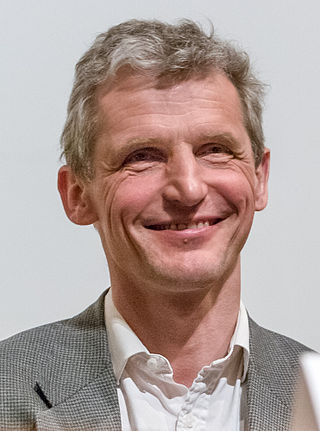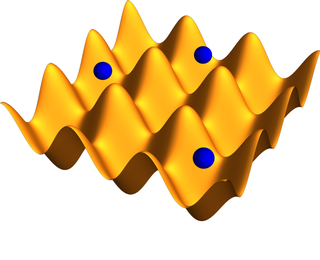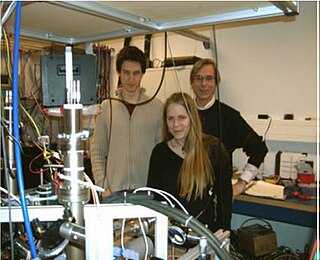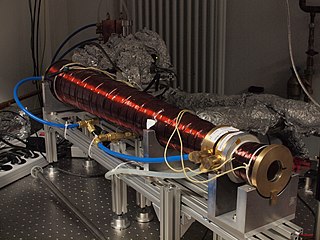
In condensed matter physics, a Bose–Einstein condensate (BEC) is a state of matter that is typically formed when a gas of bosons at very low densities is cooled to temperatures very close to absolute zero. Under such conditions, a large fraction of bosons occupy the lowest quantum state, at which microscopic quantum mechanical phenomena, particularly wavefunction interference, become apparent macroscopically.

Laser cooling includes a number of techniques in which atoms, molecules, and small mechanical systems are cooled, often approaching temperatures near absolute zero. Laser cooling techniques rely on the fact that when an object absorbs and re-emits a photon its momentum changes. For an ensemble of particles, their thermodynamic temperature is proportional to the variance in their velocity. That is, more homogeneous velocities among particles corresponds to a lower temperature. Laser cooling techniques combine atomic spectroscopy with the aforementioned mechanical effect of light to compress the velocity distribution of an ensemble of particles, thereby cooling the particles.

Deborah Shiu-lan Jin was an American physicist and fellow with the National Institute of Standards and Technology (NIST); Professor Adjunct, Department of Physics at the University of Colorado; and a fellow of the JILA, a NIST joint laboratory with the University of Colorado.
Quantum optics is a branch of atomic, molecular, and optical physics dealing with how individual quanta of light, known as photons, interact with atoms and molecules. It includes the study of the particle-like properties of photons. Photons have been used to test many of the counter-intuitive predictions of quantum mechanics, such as entanglement and teleportation, and are a useful resource for quantum information processing.

Wolfgang Ketterle is a German physicist and professor of physics at the Massachusetts Institute of Technology (MIT). His research has focused on experiments that trap and cool atoms to temperatures close to absolute zero, and he led one of the first groups to realize Bose–Einstein condensation in these systems in 1995. For this achievement, as well as early fundamental studies of condensates, he was awarded the Nobel Prize in Physics in 2001, together with Eric Allin Cornell and Carl Wieman.

Lene Vestergaard Hau is a Danish physicist and educator. She is the Mallinckrodt Professor of Physics and of Applied Physics at Harvard University.
An atom laser is a coherent state of propagating atoms. They are created out of a Bose–Einstein condensate of atoms that are output coupled using various techniques. Much like an optical laser, an atom laser is a coherent beam that behaves like a wave. There has been some argument that the term "atom laser" is misleading. Indeed, "laser" stands for light amplification by stimulated emission of radiation which is not particularly related to the physical object called an atom laser, and perhaps describes more accurately the Bose–Einstein condensate (BEC). The terminology most widely used in the community today is to distinguish between the BEC, typically obtained by evaporation in a conservative trap, from the atom laser itself, which is a propagating atomic wave obtained by extraction from a previously realized BEC. Some ongoing experimental research tries to obtain directly an atom laser from a "hot" beam of atoms without making a trapped BEC first.

An optical lattice is formed by the interference of counter-propagating laser beams, creating a spatially periodic polarization pattern. The resulting periodic potential may trap neutral atoms via the Stark shift. Atoms are cooled and congregate at the potential extrema. The resulting arrangement of trapped atoms resembles a crystal lattice and can be used for quantum simulation.

In condensed matter physics, a magneto-optical trap (MOT) is an apparatus which uses laser cooling and a spatially-varying magnetic field to create a trap which can produce samples of cold, neutral atoms. Temperatures achieved in a MOT can be as low as several microkelvin, depending on the atomic species, which is two or three times below the photon recoil limit. However, for atoms with an unresolved hyperfine structure, such as 7Li, the temperature achieved in a MOT will be higher than the Doppler cooling limit.

Optical pumping is a process in which light is used to raise electrons from a lower energy level in an atom or molecule to a higher one. It is commonly used in laser construction to pump the active laser medium so as to achieve population inversion. The technique was developed by the 1966 Nobel Prize winner Alfred Kastler in the early 1950s.
In condensed matter physics, an ultracold atom is an atom with a temperature near absolute zero. At such temperatures, an atom's quantum-mechanical properties become important.
In experimental physics, a magnetic trap is an apparatus which uses a magnetic field gradient to trap neutral particles with magnetic moments. Although such traps have been employed for many purposes in physics research, they are best known as the last stage in cooling atoms to achieve Bose–Einstein condensation. The magnetic trap was first proposed by David E. Pritchard.

Joannes Theodorus Maria (Jook) Walraven is a Dutch experimental physicist at the Van der Waals-Zeeman Institute for experimental physics in Amsterdam. From 1967 he studied physics at the University of Amsterdam. Both his doctoral research and PhD research was with Isaac Silvera, on the subject of Bose-Einstein Condensation. Because of the difficulty of his research subject, his promotion took six years instead of four. The aim of his PhD research was to make a gas of atomic hydrogen, which could become the world's first quantum gas. This might then be a suitable candidate for a Bose-Einstein Condensate (BEC).

In atomic physics, a Zeeman slower is a scientific instrument that is commonly used in atomic physics to slow and cool a beam of hot atoms to speeds of several meters per second and temperatures below a kelvin. The gas-phase atoms used in atomic physics are often generated in an oven by heating a solid or liquid atomic sample to temperatures where the vapor pressure is high enough that there are a substantial number of atoms in the gas phase. These atoms effuse out of a hole in the oven with average speeds on the order of hundreds of m/s and large velocity distributions. The Zeeman slower is attached close to where the hot atoms exit the oven and is used to slow them to less than 10 m/s (slowing) with a very small velocity spread (cooling).
In atomic physics, Raman cooling is a sub-recoil cooling technique that allows the cooling of atoms using optical methods below the limitations of Doppler cooling, Doppler cooling being limited by the recoil energy of a photon given to an atom. This scheme can be performed in simple optical molasses or in molasses where an optical lattice has been superimposed, which are called respectively free space Raman cooling and Raman sideband cooling. Both techniques make use of Raman scattering of laser light by the atoms.
Bose–Einstein condensation can occur in quasiparticles, particles that are effective descriptions of collective excitations in materials. Some have integer spins and can be expected to obey Bose–Einstein statistics like traditional particles. Conditions for condensation of various quasiparticles have been predicted and observed. The topic continues to be an active field of study.

National Laboratory of Atomic, Molecular and Optical Physics is the national inter-university research center with the headquarters at Institute of Physics of Nicolaus Copernicus University in Toruń, Poland. Established in 2002, the Laboratory is focused on atomic, molecular, and optical physics (AMO).
The I. I. Rabi Prize in Atomic, Molecular, and Optical Physics is given by the American Physical Society to recognize outstanding work by mid-career researchers in the field of atomic, molecular, and optical physics. The award was endowed in 1989 in honor of the physicist I. I. Rabi and has been awarded biannually since 1991.
Polarization gradient cooling is a technique in laser cooling of atoms. It was proposed to explain the experimental observation of cooling below the doppler limit. Shortly after the theory was introduced experiments were performed that verified the theoretical predictions. While Doppler cooling allows atoms to be cooled to hundreds of microkelvin, PG cooling allows atoms to be cooled to a few microkelvin or less.












